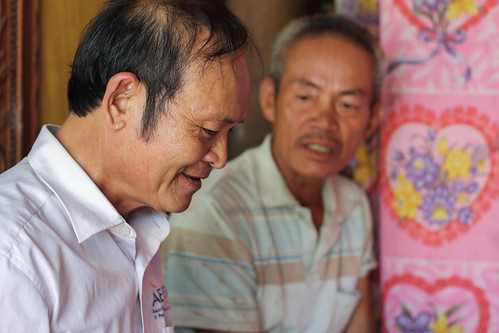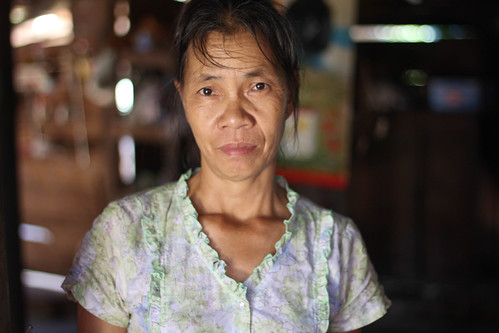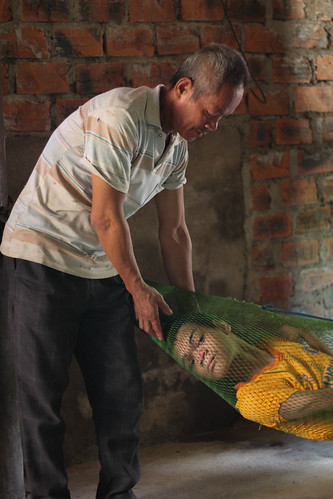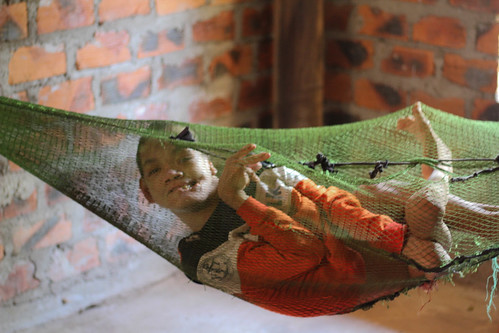I had the pleasure of going on my first field trip on the fourth of July to the Tuyen Hoa district with Mr. Hoc (an AEPD Outreach Worker), Ngoc (AEPD staff), and Ashley and Seanin (summer interns from Canada). We met with Mr. Thin’s family—the tenth and latest Agent Orange Campaign beneficiary.
What is the Agent Orange Campaign? The Agent Orange Campaign supports families affected by Agent Orange in the Quang Binh province by connecting them to an AEPD Outreach Worker and resources. By collaborating with an Outreach Worker, they are able to develop a business plan for sustainable income generation. Read my introductory blog here for a more in-depth look into the Campaign and my role for the next six months.
In the spirit of responsible and ethical storytelling, I thought it best to introduce Mr. Thin and his family through a photo diary. I firmly believe in the power of photography as I find that words often fail to faithfully capture reality.
We arrived at Mr. Nguyen Ngoc Thin’s home around 10:00am after a three-hour drive from Dong Hoi City. The air was hot, the landscape lush, and the raw cement floor refreshing. He welcomed us into the home and instantly shared their experiences as a family affected by Agent Orange and the plans he and Mr. Hoc had developed in January when Karen (Advocacy Project staff) met with them for the first time.
Since Karen’s visit in January, Mr. Thin has been able to secure a loan for grapefruit and banana tree seeds and plant them. During this visit, the business plan was updated to reflect these accomplishments and determine estimated revenue, costs, profits, and the remaining need. It was determined that the family needed a cow and a calf. The female cow’s manure will be used to fertilize the crops; the calf will be sold for income, as will the following seven calves she is expected to bear. The income from the calf sales and the crops will be used to support the household, purchase food and medicine, and begin repaying the loan.
Ms. Cao Thi Loan, Mr. Thin’s wife, poses for a portrait.
She has been listening intently while Mr. Hoc and Mr. Thin discuss the business plan and next steps. Occasionally she interrupts to add her perspective and then retreats to check in on Lam and Phan and finish preparing lunch. No one mistakes her silence for complacency, as we are keenly aware that she is a strong woman and a partner in this household.
Mr. Thin and Ms. Loan are the primary caregivers of their sons, Nguyen Van Phan (23 years old) and Nguyen Van Lam (30 years old). Their sons’ quality of life is severely impacted by their cerebral palsy associated with the couple’s environmental exposure to Agent Orange. They had five children, all with cerebral palsy. Lam and Phan are the surviving two. Nevertheless, it is obvious that Mr. Thin and Ms. Loan take good care of their sons–keeping them clean and preserving their dignity.
Unfortunately, the family is ineligible to receive government-funded Agent Orange compensation because Mr. Thin joined the army after 1975. Instead, the family receives social assistance for persons with disabilities but it is not enough to maintain the household.
Mr. Thin carefully adjusts Phan’s head before posing for the family portrait (above).
Mr. Thin supports the family through agriculture; in addition to the 600 banana and grapefruit trees he has recently planted, he currently maintains 20 grapefruit trees and keeps two pigs. He mentions that while there has been no change in Lam and Phan’s health, he and his wife are aging and are no longer very healthy. Unfortunately, they are only able to access treatment in the local clinic because the hospital is far away and they cannot leave their sons alone.
Lam and Phan spend the majority of their time enveloped by their hammocks. This is the most secure place for them to stay. The family has found that they otherwise roll off beds and injure themselves. It allows Ms. Loan, as their primary caregiver, some peace of mind.
As we chat and I take additional photographs, we notice two wheelchairs in the corner. The family was gifted them by a chapter of the Red Cross in the district. Ms. Loan explains that she fastens them to their wheelchairs and takes them outside for sunshine. Although she does that fairly often, she continues, it is difficult to ensure their safety.
Lam is the family’s oldest surviving son. His hammock is nearest the window. The sun gently beams against his skin as he sways. I greet him as I approach and he repeats “Hello”. Ms. Loan mentions that he repeats sounds he hears but does not understand them. His eyes track the camera as we continue to engage with him, Phan, and Ms. Loan.
Mr. Thin had slipped out at some point during our conversation with them to obtain local authority approval for our visit. Mr. Hoc explains that we will meet him at the station. We say goodbye to them and see ourselves out. As we are leaving, I glance back at them and see Ms. Loan swiftly, yet gently, lifting Lam from his hammock onto the mat where she will feed him lunch. It feels so natural, so practiced and then I remember she has been doing this for the last 30 years.
It was a privilege to meet Mr. Thin and his family and I am thrilled to collaborate with them throughout my fellowship. AEPD and AP have launched a crowdfunding campaign to support Mr. Thin’s business plan. Please consider joining them as they invest in their future.
For more photographs of the field visit and Mr. Thin’s family, click here.
For an in-depth profile of the Thin family, click here.
For more on the Association for the Empowerment of Persons with Disabilities (AEPD), Advocacy Project’s partner in Vietnam, click here.
Posted By Marcela De Campos (Vietnam)
Posted Jul 11th, 2018









1 Comment
Princia Vas
July 23, 2018
Thank you for sharing these amazing pictures. I loved reading and knowing more about the Agent Orange Campaign.Thanks for the update on the project itself!